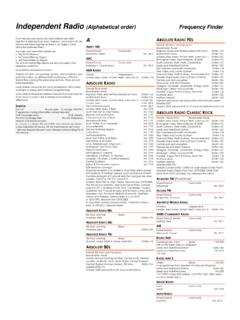Transcription of iSeries Availability and Independent Auxiliary …
1 8 2002 IBM CorporationiSeries Availability and Independent Auxiliary storage Pools - 107/27/028 2002 IBM Disk Pools Cluster Resource ServicesJournal enhancementsHTTPW indows & xSeries IntegrationBackup & RecoveryBRMST ivoli storage - 207/27/028 2002 IBM : AgendaThis foil lists the topics covered in this this presentation Independent Disk Pools ( Independent Auxiliary storage Pools (IASPs) are also discussed from a server consolidation viewpoint. This is because V5R2 IASP support provides functions than enable having multiple "name spaces" (commonly thought of as "multiple databases") on the same system or, in an LPAR environment, within the same V5R1 IASPs became available as tools for increasing system Availability .)
2 In V5R1 IASPs did not support objects stored in the iSeries file system With V5R2 most objects, including database objects, such as tables, views and indexes can be supported in an Database presentation has additional details for using an IASP to support multiple databases on the same system or partitionThis enables V5R2 IASPs to be considered both in an Availability environment as well as a server consolidation environment. For more detailed assistance in planning and implementing the use of IASPs in either a server consolidation or increased Availability environment, we recommend contacting the iSeries Technology Center in Rochester, Minnesota, USA at: - 307/27/028 2002 IBM Disk storage Pools - 407/27/028 2002 IBM Disk Pools Disk poolsSupport for library-based objectsSwitchable and non-switchable Disk Pool Groups Multiple databasesObject Management PlanningBackup, Recovery of IASPsAdvantages of using IASP sand other - 507/27/028 2002 IBM disk pools provide the ability to group together storage that can be taken off-line or brought online Independent of system data or other unrelated data.
3 An Independent disk pool can be either:Privately connected to a single system. Also known as stand-alone or primary IASPsSwitched among multiple systems or partitions in a clustered environmentClearly, this is quite a departure from the way in which Auxiliary storage (disk) has been regarded prior to V5R1. Until then, all iSeries disks were considered to be owned and usable by a single system only. Enhancements made to OS/400 in V5R1 and again in V5R2 make the use of Independent disk pools a very attractive option for many customers looking for higher levels of Availability or server : In this presentation we interchangeably use the acronym IASP to be identical to the term " Independent disk pools.
4 " As yo u will see in this presentation, iSeries Navigator uses the term "disk pools" to refer to Auxiliary storage Pools (ASPs) and a prefix adjective that uniquely classifies the ASP to be dependent or Independent (UDFS, Primary, Secondary).Primary and Secondary can contain OS/400 libraries and library objects. UDFS corresponds to the V5R1 support which does not include OS/400 library-based objects. The next foil has more : Independent Disk Pools - 607/27/028 2002 IBM PoolsSystem ASPASP# 1OS/400 Basic ASP# 2-32 Also known as User or Dependent ASPsIndependent (IASP)ASP# 33-255 User Defined File System (UDFS)No objects. Can be converted to Primary orSecondary pools for library based object supportPrimary ( objects) - 707/27/028 2002 IBM set of one or more storage units selected from all available disk units.
5 Disk pools (also known as Auxiliary storage pools) provide a means of placing certain objects on specific disk units to prevent the loss of data due to failures of disk units in other disk Independent disk pools were introduced in V5R1, they supported user-defined file systems (UDFS) only. Support for library-based ( ) objects has been added in V5R2. You can now create as many as 223 Independent disk pools. Previous releases only supported 67 Independent disk pools. In V5R1 Independent disk pools were numbered from 33-99. That range has been expanded to 33-255 at V5R2. See "Supported and unsupported OS/400 object types" in the iSeries Information Center for details. There are three types of disk pools, also known as Auxiliary storage pools (ASPs):System The system automatically creates the system disk pool (Disk Pool 1) which contains disk unit 1 and all other configured disks that are not assigned to a basic or Independent disk pool.
6 The system disk pool contains all system objects for the OS/400 licensed program and all user objects that are not assigned to a basic or Independent disk pool. You can see the system ASP as Disk Pool 1 in Prior to V5R2, Auxiliary storage Pools 2 to 32 were known as User ASPs. The function of these has not changed but they are now often referred to Basic User ASPs or Basic Disk Pools in V5R2. Prior to V5R2 they were referred to as Dependent A disk pool that contains objects, the directories or libraries that contain the objects, and other object attributes such as authorization and ownership attributes. An Independent disk pool can be made available (varied on) and made unavailable (varied off) to the server without restarting the system.
7 When an Independent disk pool is associated with a switchable hardware group, it becomes a switchable disk pool and can be switched between one iSeries server and another iSeries server in a clustered environment. An Independent disk pool that is not associated with a cluster resource group is referred to in OS/400 application programming interfaces (APIs) as a private disk pool or non-switchable IASP. Independent disk pools can also function in conjunction with other Independent disk pools in a disk pool group. In the upper right window pane you can see "statistics" are known for the system ASP and IASP 33 (named Dbitsc). IASP Dbitsc has been varied on to the local system so the system "knows the disk configuration is active.
8 IASP disk pool 34 (Europe) % Used and amount of Free Space. statistics are not known because this Notes: Disk - 807/27/028 2002 IBM type of IASPs can be defined in V5R2:User-defined file system (UDFS) An Independent disk pool that contains only user-defined file systems. A UDFS disk pool cannot be a member of a disk pool group unless it is converted to a primary or secondary disk pool. An UDFS IASP is generally the equivalent to the only IASP support in An Independent disk pool that defines a collection of directories and libraries and may have other secondary disk pools associated with it. A primary disk pool also defines a database for itself and other disk pools that may be added in its disk pool group.
9 Primary disk pools can only be implemented on V5R2 or later of An Independent disk pool that defines a collection of directories and libraries and must be associated with a primary disk pool. Secondary disk pools can only be implemented on V5R2 or later of OS/400. A secondary pool is optional. Though not practical, you can , in theory, have as many as 200 or more secondary pools. Additional details are provided in the following : Disk Pools - 907/27/028 2002 IBM Pool GroupsCombine iASPs to one entityMade up of:a primary disk poolzero or more secondary disk poolsLogically connects disk poolsVary them On/Off togetherSwitch them togetherShare the same databaseSimilar as System ASP and basic ASPsFor example:Primary Independent ASP for libraries and database filesSecondary Independent ASP for journals and journal receiversSystem ASPB asic 2-32iASP# 33-255 UDFSP rimarySecondaryPool Groups for Multiple DatabasesPrimaryPrimarySecondarySecondar yThe System Database is referred to as - 1007/27/028 2002 IBM.
10 Disk Pool GroupsA disk pool group is made up of a primary disk pool and zero or more secondary disk pools. Each disk pool is Independent in regard to data storage , but in the disk pool group they combine to act as one entity. If you make one disk pool available or unavailable, the rest of the disk pools in the group are also made available or unavailable at the same time. Also, in a clustered environment, all of the disk pools in a group switch to another node at the same time. The primary and secondary disk pools also share the same database. An example of a practical use for a secondary IASP disk pool group would be for journals and journal receivers. The primary disk pool could contain the libraries and objects to be journaled, while the secondary disk pools could contain the associated journal receivers.






